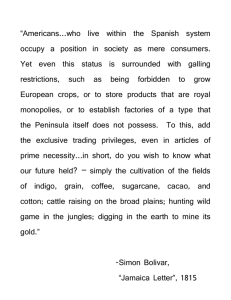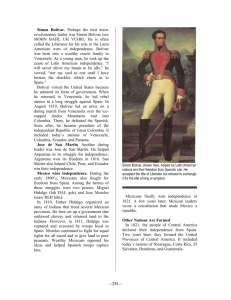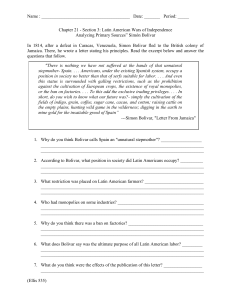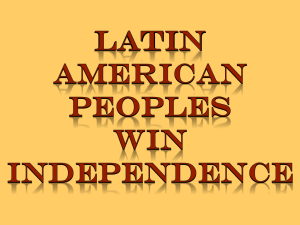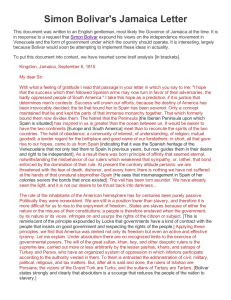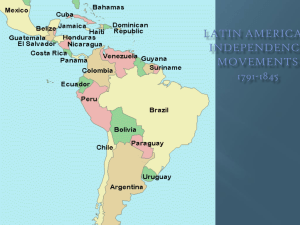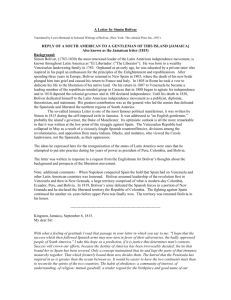40. Twilight of the Spanish Empire
advertisement
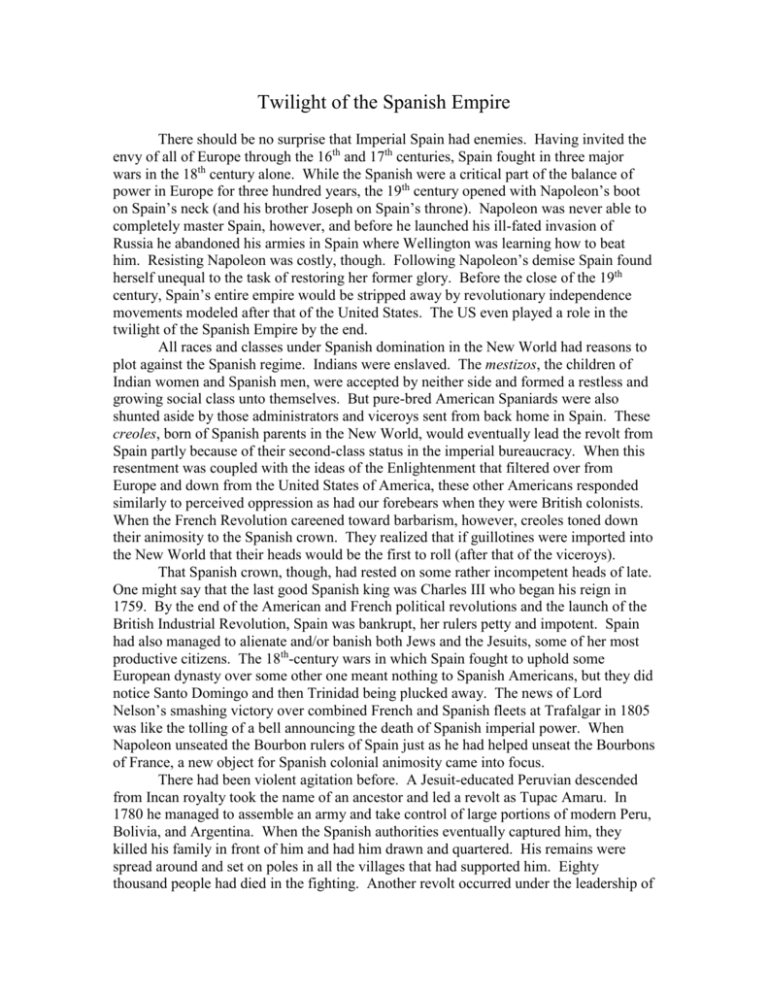
Twilight of the Spanish Empire There should be no surprise that Imperial Spain had enemies. Having invited the envy of all of Europe through the 16th and 17th centuries, Spain fought in three major wars in the 18th century alone. While the Spanish were a critical part of the balance of power in Europe for three hundred years, the 19th century opened with Napoleon’s boot on Spain’s neck (and his brother Joseph on Spain’s throne). Napoleon was never able to completely master Spain, however, and before he launched his ill-fated invasion of Russia he abandoned his armies in Spain where Wellington was learning how to beat him. Resisting Napoleon was costly, though. Following Napoleon’s demise Spain found herself unequal to the task of restoring her former glory. Before the close of the 19th century, Spain’s entire empire would be stripped away by revolutionary independence movements modeled after that of the United States. The US even played a role in the twilight of the Spanish Empire by the end. All races and classes under Spanish domination in the New World had reasons to plot against the Spanish regime. Indians were enslaved. The mestizos, the children of Indian women and Spanish men, were accepted by neither side and formed a restless and growing social class unto themselves. But pure-bred American Spaniards were also shunted aside by those administrators and viceroys sent from back home in Spain. These creoles, born of Spanish parents in the New World, would eventually lead the revolt from Spain partly because of their second-class status in the imperial bureaucracy. When this resentment was coupled with the ideas of the Enlightenment that filtered over from Europe and down from the United States of America, these other Americans responded similarly to perceived oppression as had our forebears when they were British colonists. When the French Revolution careened toward barbarism, however, creoles toned down their animosity to the Spanish crown. They realized that if guillotines were imported into the New World that their heads would be the first to roll (after that of the viceroys). That Spanish crown, though, had rested on some rather incompetent heads of late. One might say that the last good Spanish king was Charles III who began his reign in 1759. By the end of the American and French political revolutions and the launch of the British Industrial Revolution, Spain was bankrupt, her rulers petty and impotent. Spain had also managed to alienate and/or banish both Jews and the Jesuits, some of her most productive citizens. The 18th-century wars in which Spain fought to uphold some European dynasty over some other one meant nothing to Spanish Americans, but they did notice Santo Domingo and then Trinidad being plucked away. The news of Lord Nelson’s smashing victory over combined French and Spanish fleets at Trafalgar in 1805 was like the tolling of a bell announcing the death of Spanish imperial power. When Napoleon unseated the Bourbon rulers of Spain just as he had helped unseat the Bourbons of France, a new object for Spanish colonial animosity came into focus. There had been violent agitation before. A Jesuit-educated Peruvian descended from Incan royalty took the name of an ancestor and led a revolt as Tupac Amaru. In 1780 he managed to assemble an army and take control of large portions of modern Peru, Bolivia, and Argentina. When the Spanish authorities eventually captured him, they killed his family in front of him and had him drawn and quartered. His remains were spread around and set on poles in all the villages that had supported him. Eighty thousand people had died in the fighting. Another revolt occurred under the leadership of Toussaint L’ Ouverture directly against French rule in Haiti. The French Revolution outlawed slavery, and Haiti’s half million African slaves responded by pillaging and burning. Toussaint led a poorly-equipped army of blacks in successive attacks against French, British, and Spanish forces until he controlled the whole island. Napoleon sent 54 ships and 23,000 men to assert French control and still lost due to the effects of yellow fever on his soldiers. Under a truce, however, Toussaint came to negotiate with the French commander and was seized, chained, and thrown on a ship only to die in a French prison in 1803. Haiti won its independence the next year, the first part of all Latin America to cut its ties to Europe. These and other revolts stirred up the city leaders of Caracas, Bogotá, Quito, and Santiago to renounce Napoleon’s puppet Joseph in 1810, the beginning of serious revolutions. You’ll notice that Mexico City is not among the list of cities in revolt above. Despite some instability, the Spanish rulers of Mexico in the fateful year of 1810 held onto power in their capital. The Mexican Revolution, then, is the only one at this stage to originate in the countryside. The instigator was a priest named Father Miguel Hidalgo y Costilla, a poor farmer’s son. While a brilliant scholar, he had invited criticism by fathering two daughters, reading Rousseau, and questioning key Roman Catholic doctrines as a result of his fondness for other French philosophes. For these indiscretions he was relegated to the village of Dolores, a backwater he subsequently turned into a thriving economic center that even could boast of an orchestra! Hidalgo saw his duty as a priest to side with the downtrodden, in this case the Indians and the mestizos. Assembling a ragged “army” of these outcasts, he shouted, “My children . . .will you be free? Will you . . . recover from the hated Spaniards the lands stolen from your forefathers three hundred years ago?” The crowd roared in response with the battle cry Hidalgo had taught them, “Long live our Lady of Guadalupe, down with bad government, death to the Spaniards!” Armed with bows and arrows, clubs, pikes, machetes, and a few guns, fifty to sixty thousand men marched behind the banner of the Virgin of Guadalupe. The Mexican Revolution commenced thus on September 16th, 1810, and that date is still celebrated as Independence Day in Mexico. Hidalgo was an exuberant man but a poor organizer. His “troops” raged from town to town, overwhelming the Spanish defenders by sheer force of numbers, and then killing Spanish inhabitants. In March of 1811, however, Hidalgo was captured, stripped of his priest’s robes, and executed by a firing squad. A follower of Hidalgo, another priest named Morelos, proved to be a much more skillful leader but was also captured and shot. Morelos had declared Mexico’s independence, however, and drafted a constitution by 1814. In the floundering that followed the deaths of the priests, a growing dissatisfaction with the rule of Spain mounted among large numbers of Mexican creoles, many of whom were rich. In the confusion a Spanish officer name Agustín de Iturbide switched sides and brought his 2,500 seasoned troops with him. He also raided a silver caravan and seized half a million pesos for the cause. Iturbide called his forces, “The Army of the Three Guarantees,” which were religion (Roman Catholicism), independence, and union. These goals appealed to nearly everyone, and more Spanish generals brought their armies with them to join the quest for independence that was finally successful in 1821, although the three guarantees did little to secure the rights of the Indians and mestizos who had begun it all. For a time Guatemala joined forces with Mexico, and then broke away on its own by 1823 to head what was known as the Central American Federation. Meanwhile, other revolutions erupted down in South America under the leadership of two military commanders—Simόn Bolivar in the north and José de San Martín in the south. Bolivar gloried in the adulation of his followers and viewed himself a great player on a stage while Martín quietly accomplished all the same goals as Bolivar without the fanfare. The two leaders are a study in contrasts but share the major credit for banishing the Spanish from the continent of South America. Before losing control of his revolution, Simόn Bolivar formed the nations of Venezuela (where he was born), Colombia, Ecuador, Peru, and Bolivia. Martín freed much of the rest including Chile, Argentina, and part of Peru. Bolivar was from a rich family and had a private tutor who was a disciple of Jean Jacques Rousseau. When sent to Spain for more education, he met and married an aristocrat’s niece who died upon their return to Caracas. Bolivar vowed never to marry again and spent several years of turbulent living in Europe from Paris to Rome where he vowed to never rest until he had broken Spain’s hold on his homeland. The revolutionary year of 1810 found him in England asking for aid to help the rebels of Venezuela. Having inherited a fortune, Bolivar made himself the leader of the rebellion at the age of 27. In Napoleonic style he met with some reverses, was exiled, and then returned home to declare the independence of Venezuela by 1813 and to be its dictator by 1814. After the real Napoleon was out of the way, however, the restored king of Spain, Ferdinand, sent overwhelming forces to crush Bolivar’s rebellion. Having fled to Jamaica, he decried the passivity of much of the people of Latin America and Spain’s systematic exploitation of her New World citizens. Bolivar bounced from Jamaica to what would become Colombia to Haiti where he finally found additional support. He tried again to launch a revolt in Venezuela but again followed the pattern of Napoleon by abandoning his small force when Spanish armies drew too close. Then Bolivar’s fortunes changed. He gave up on seizing Caracas and instead concentrated on a productive area in the far south of Venezuela. Some Cossack-like horse soldiers joined his forces as did some adventurers from Great Britain by 1819. These recruits attracted enough indigenous forces for Bolivar to be declared The Liberator and to form a congress. Bolivar unveiled a plot to create a new empire under his control and to call it Gran Colombia (which would have combined at least Venezuela, Colombia, and Ecuador). His followers were suspicious, but as royal power back in Spain weakened, Bolivar rid all of Venezuela of Spanish armies by 1823. While almost no one else favored the plan of a combined nation under his rule, Bolivar’s enthusiasm swept his armies south into Peru where he defeated the Spanish in a battle 9,300 feet up the slope of a mountain. Having mentioned Peru, we must now retrace our steps and pick up the exploits of the less flamboyant Martín. He had begun his military career at the age of 11. By age 33, he was a lieutenant colonel fighting Napoleon in Spain. The year 1810 found him back in his homeland of South America leading forces over the Andes Mountains to reinforce the patriots of Chile who then followed him north to ignite the revolt of Lima, the citadel of Spanish power in all South America. This brief expedition served to convince him that South America would never be truly free until Spain’s grip on Peru was shattered. He helped liberate Buenos Aires which he used as a base to build up his forces as more and more insurgents flocked to him. When leaders of an impromptu congress could not decide, though, whether to go back to Spanish rule, make a king of their own, or establish a republic, Martín presumably could relate to Bolivar’s frustrations. Martín remarked, “This does not seem to be a revolution of men but of sheep.” He urged the congress that, “Great undertakings are for men of courage,” and they finally declared independence in 1816. Events accelerated. Martín led a new army back over the Andes and took Spanish forces in Chile completely by surprise. After routing the Spanish by 1817, the city of Santiago wanted to declare him governor, but Martín declined, something Bolivar would never have done. Then the city gave him 10,000 pesos which he donated to a hospital. For three years Martín strengthened his army. He crossed the Andes seven times in this period to secure more support. Finally in 1820 he marched his army into Peru. He avoided what many of his followers urged, a strike against the capital at Lima, and instead rallied more support as more volunteers joined his ranks. The timing of instability back in Spain that had helped Bolivar also aided Martín who marched into Lima unopposed in 1821 and declared the independence of Peru. To win independence, however, called for extreme measures. Most of Peru was still under the control of Spanish garrisons, and the local upper classes had little will to fight. The one title Martín took, then, was that of dictator of Peru in order to gain more control over wavering elements of Peruvian society. He realized his only true hope lay in combining forces with Bolivar the Liberator. Bolivar must have seen this point, too, for he wrote to Martín, “We should draw closer together and agree to engage with the new enemies. . . “ Martín responded, “Peru will receive with enthusiasm and gratitude all the troops your Excellency can spare.” In 1822 Martín sailed north to meet face to face with Bolivar after an exchange of letters dripping with excessive mutual praise. When they met Bolivar proposed a toast, “To the two greatest men in South America—General San Martín and myself.” For his part, Martín responded, “To the early end of the war; to the organization of the republics of the continent and to the health of the Liberator of Colombia.” I told you they were different. Bolivar, apparently, could not trust Martín’s assurances that he would fight as his subordinate. The two men failed to come to an agreement, and Martín left Bolivar never to see him again. The Dictator of Peru retired to Chile, apparently to await developments. When he perceived that his presence caused Bolivar to delay, he simply resigned. When he heard news of his wife’s premature death, he returned to Buenos Aires, collected his daughter, and then sailed for England. He lived in voluntary exile the rest of his life in Belgium, then Paris, then Boulogne where he died in 1850. Not until 1880 were his remains returned to Argentina and buried beneath the cathedral in Buenos Aires. Simόn Bolivar was free to act alone. Large Spanish forces waited somewhere in Peru while news mounted of dissension among the peoples lumped together in Gran Colombia. Bolivar marched into Lima in a triumphal procession that belied his growing uneasiness. His closest friends were the British officers on his staff and one loyal lieutenant. The climax of the revolutions of Latin America came in 1824 at the Battle of Ayacucho. Before the armies clashed, however, men from both sides left their ranks and crossed over to enemy lines to exchange courtesies with brothers and friends revealing that 14 years of revolutionary wars amounted really to a tragic civil war. When the battle commenced, Bolivar proved victorious despite being outnumbered by 3,000 men. The Spanish loss was so profound their viceroy and chief generals were taken prisoner. The Battle of Ayacucho was the end of the wars of Spanish American independence. While mopping up the last of the Spanish resistance, a southern province of Peru sought independence. Bolivar’s wrath was blunted in that the new country was named Bolivia. It was the beginning of the end of Gran Colombia. Other factions arose. Bolivar marched his army north in an effort to stabilize his dream, but eventually wrote, “There is no good faith in America, nor among the nations of America. Treaties are scraps of paper; constitutions, printed matter; elections, battles; freedom, anarchy; and life, a torment.” By 1830 both Venezuela and Ecuador withdrew form Colombia. That same year, Bolivar followed Martín into self-imposed exile in Europe but did not make it out of the Caribbean. He died of tuberculosis after having written, “America is ungovernable. Those who have served the revolution have plowed the sea.” Perhaps this is all Rousseau’s fault. A dreamer himself, Rousseau believed utopia was possible while never actually trying to govern anyone. Rousseau liked to go on long walks in the woods, something for which generals and dictators have little time for save while on the march. His writings redeemed the Enlightenment from abject materialism and murderous rationalism, but left priests and soldiers and their followers believing they would avoid the mistakes of Napoleon and his followers and become the men of the age. With the convulsions set in motion by the decline of global empires, dozens of Napoleons saw their chance. Many were as flashy as Bolivar. Some were as stolid as Martín. And then, to borrow from Abraham Lincoln, there came men who “made no pretense of loving liberty.” Many of this ilk still rule impoverished “utopias.”
